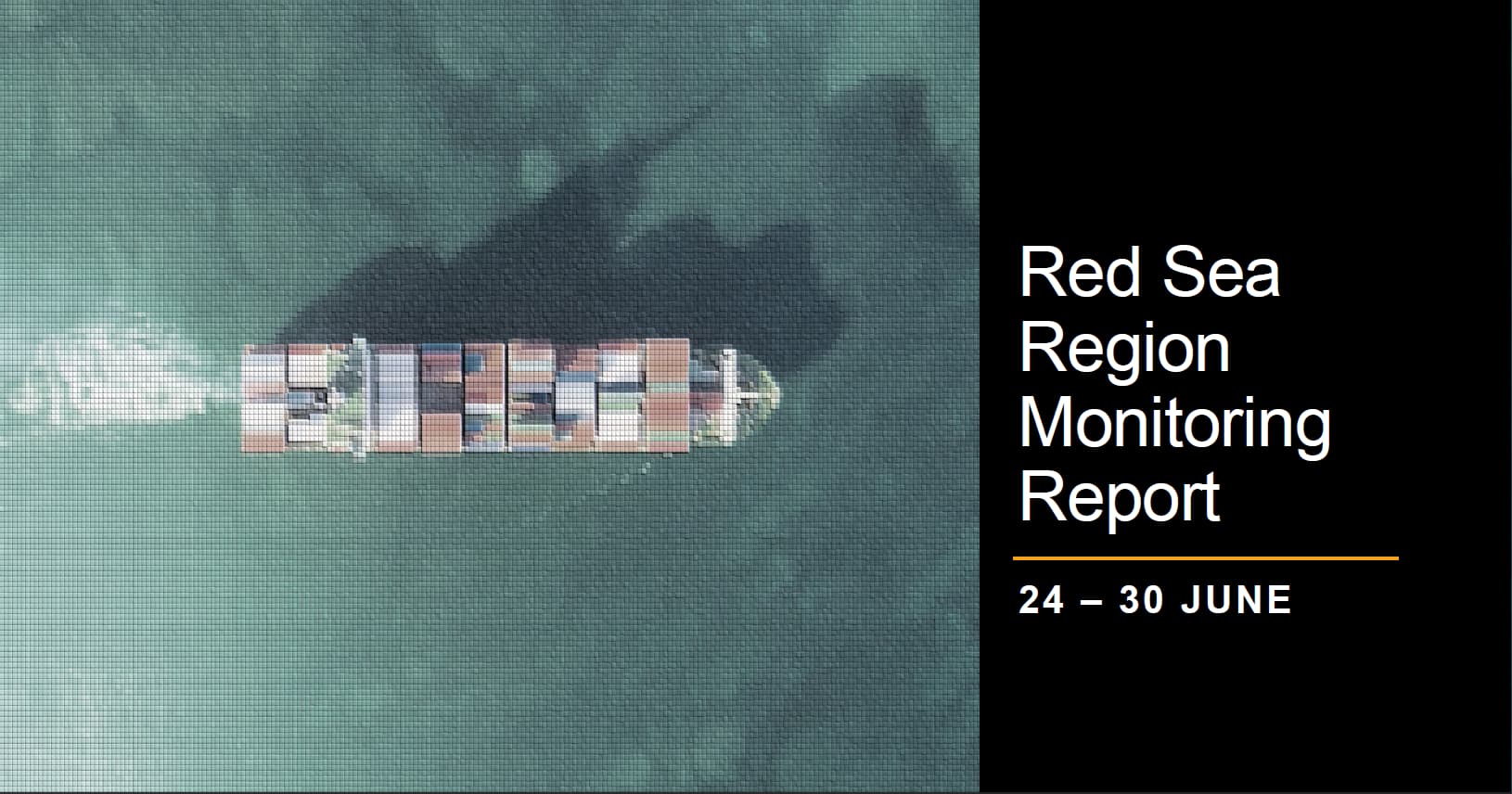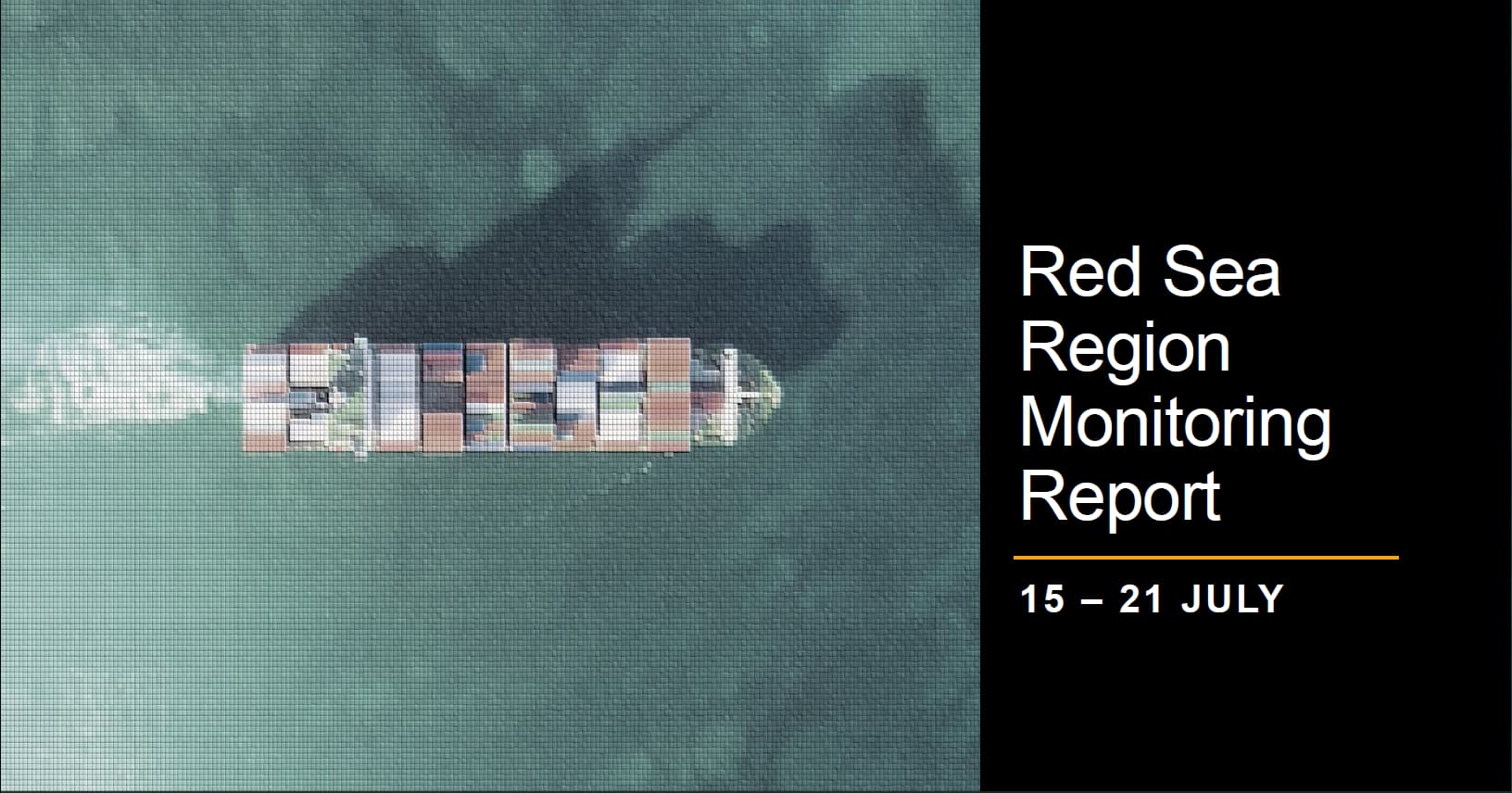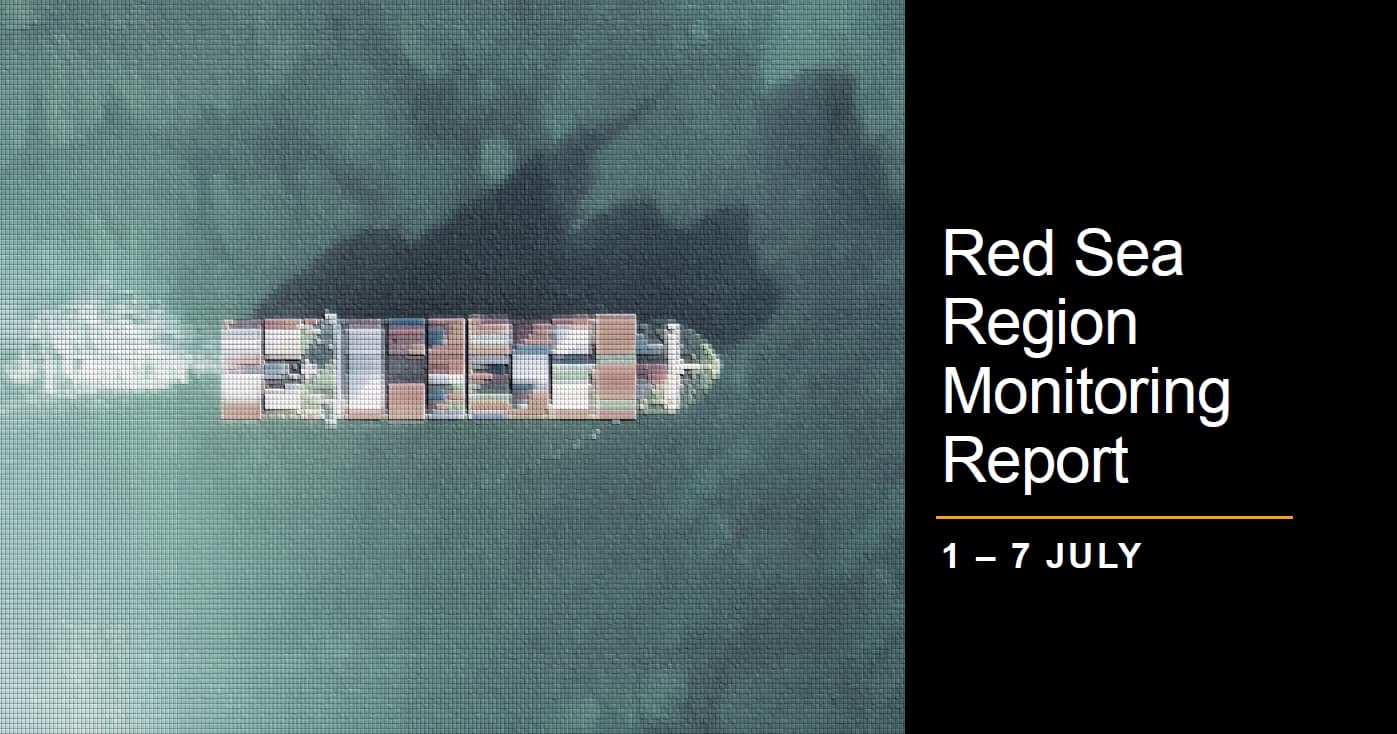KEY DEVELOPMENTS – COMMERCIAL INCIDENTS
During the monitoring period 13 – 19 May Regal Maritime Solutions (RMS) identified the following incidents in the Red Sea and Gulf of Aden region:
MISSILE STRIKE: On 18 May at approximately 0100 local time Houthi militants launched one anti-ship ballistic missile (ASBM) into the Red Sea and struck the M/T Wind, a Panamanian-flagged, Greek owned and operated oil tanker approximately 98NM south of Al Hudaydah. The strike hit its port quarter, resulting in flooding aboard and the loss propulsion and steering, which was later restored by the crew. The M/T Wind was able to resume its course under its own power. No injuries were reported amongst the crew.
IRANIAN INTELLIGENCE VESSEL: There have been no updates on the Iranian intelligence vessel the Behshad during the reporting period. Its last reported location was on 18 April in the Persian Gulf in Iranian territorial waters. It was located in the vicinity of coordinates 26° 59′ 26.2″ N, 056° 24′ 35.2″ E located approximately 5NM south of Banda Abbas, Iran and south west of the
island of Hormuz.

KEY DEVELOPMENTS – MILITARY ACTIVITY
During the monitoring period 13 – 19 May RMS identified the following incidents involving US coalition forces in the Red Sea and Gulf of Aden region, obtained from military and open sources:
UAV INTERCEPT: On 13 May at approximately 1541 local time, US forces successfully destroyed one unmanned aerial vehicle (UAV) in a Houthi controlled area of Yemen.
UAV/MISSILE INTERCEPT: On 13 May between approximately 1751 and 1802 local time, the US warship, the USS Mason engaged and destroyed one inbound anti-ship ballistic missile (ASBM) launched by Houthi militants from Yemen over the Red Sea. US forces also destroyed one UAV launched by the same group from Yemen over the Red Sea. No injuries or damages reported by US, coalition, or commercial vessels.
UAV INTERCEPT: On 14 May at approximately 2100 local time, US forces destroyed four UAVs in Houthi controlled areas of Yemen.
HOUTHI UAV INTERCEPT: On 17 May Houthi militants claimed to have successfully intercepted
and destroyed an US MQ-9 Reaper drone with a surface-to-air missile over Marib province, Yemen
MISSILE STRIKE: On 18 May a coalition vessel responded to the distress call by M/T Wind after it was struck at approximately 0100 local time, by a Houthi launched missile resulting in damage aboard the vessel that impeded its propulsion and steering ability. However, no assistance was required from the coalition warship after the crew was able to restore propulsion and steering. No casualties were reported. The M/T Wind resumed its course under its own power. The vessel was enroute from Russia to China at the time.
MISSILE ATTACK: On 19 May at approximately 2135 local time, Houthi militants launched one anti-ship ballistic missile (ASBM) from a Houthi-controlled area in Yemen over the Gulf of Aden but did not strike any vessels.

KEY DEVELOPMENTS – HOUTHI MISSILE STATISTICS

Figures 1 and 2 identifies the number of missiles, UAV, USVs and UUVs launched, or prepared to be imminently launched, by Houthi militants from Yemen targeting commercial and naval vessels in the Red Sea and Gulf of Aden regions. Figures have incorporated statistics from vessels hit, near misses and pre- emptive strikes on-land in Yemen by US-led Coalition forces but not those resulting from large scale coordinated military action. In some cases the destined target of Houthi weapons including destroyed on-land in Yemen cannot not be verified and has therefore been categorised as ‘Not Known’ (NK). Where no dates are provided there were no reported incidents or data available for that period.
ANALYSIS: Houthi missile and UAV launches over the reporting period continues at a low but steady rate similar to the two weeks prior with attacks over the period mainly focused on the Red Sea. Despite this, pre-emptive strikes on Houthi controlled Yemen territory accounted for the majority of the missiles/UAVs detected and destroyed. Similar to previous weeks the majority of weaponry destroyed were UAVs with a total of six destroyed. Meanwhile of the three missiles detected two were destroyed and one missed its target in the Gulf of Aden.
KEY DEVELOPMENTS – SECURITY INCIDENT MAPPING

REGIONAL DEVELOPMENTS
During the monitoring period 13 – 19 May RMS identified the following key regional developments:
On 16 May, US forces supporting the humanitarian mission to deliver additional aid to Palestinian civilians successfully anchored a temporary pier to the beach in Gaza. This has enabled trucks carrying humanitarian aid to move ashore and enter the enclave. The aid will be passed to the United Nations who will coordinate its distribution into Gaza. No US troops entered Gaza during the event.
On 17 May, Houthi militants claimed to have successfully intercepted and destroyed an US MQ-9 Reaper drone with a surface-to-air missile over Marib province, Yemen. The incident follows on from an earlier MQ-9 drone intercept on 25 April. US forces have so far lost at least five drones to Houthi militants since 2014.
On 19 May, Iranian Iran’s President Ebrahim Raisi and Foreign Minister Hossein Amir- Abdollahian were killed in a helicopter crash along with several other members of their entourage. The President was travelling from a dam opening ceremony on the Azerbaijan border to the Iranian city of Tabriz when the incident occurred. The cause of the crash remains unclear, however the head of Iran’s Armed Forces has launched an investigation into the circumstances of the incident. Iranian state media have claimed the crash to be a consequence of a ‘technical fault’. Israel has denied any involvement in the accident.
Iran’s vice President Mohammad Mokhber has been appointed as acting president, while Ali Bagheri Kani, who was deputy foreign minister, has been named foreign minister. The date for the presidential election has been set for 28 June as a consequence of Raisi’s death.
Israeli experts believe Raisi’s replacement will have little impact on Iran’s current assertive posture in the Middle East and in particular towards Israel. The real power lays with the supreme leader, Ayatollah Ali Khamenei, and the Islamic Revolutionary Guards Corps (IRGC) in which Raisi was considered a ‘yes man’ and advocate to Khamenei’s policies. Raisi was considered a hardliner and a potential candidate to replace the ageing Khamenei as Supreme Leader upon his death.
Iran’s proxies in the region – Hamas, Hezbollah, and the Houthis – extended Iran their sympathies over the death of Raisi.
Israeli continues to conduct military operations across Gaza, as the US national security adviser Jake Sullivan met Israeli Prime Minister Benjamin Netanyahu on 19 May. The US is attempting to persuade Israel to avoid a full-scale military ground offensive on the southern Gazan city of Rafah by taking a more focused approach.
Sullivan’s meeting with Netanyahu follows a meeting between Sullivan and Saudi Prince Mohammed bin Salman to discuss a final draft version of strategic agreements between the two countries.
Jordanian Foreign Minister Ayman Safadi stated his country demands an international investigation into the many war crimes reportedly committed during Israel’s military campaign in Gaza. The announcement comes ahead of an International Criminal (ICC) announcement following similar accusations by members of the international community, media and NGOs on 20 May.
The Houthi attack on the M/T Wind on 18 May, which was enroute from Russia to China, demonstrates the Houthi’s limited intelligence verification process and/or command and control processes as to prevent the targeting of Russia-China linked vessels by its units, after they had previously agreed with both countries not to target vessels linked to them.
ASSESSMENT
- The Red Sea, Gulf of Aden, Somalia, Arabian Sea and Indian Ocean remain a high risk of piracy and of vessel damage from Houthi attacks in the region.
- The death of the Iranian President Raisi is likely to have minimal to no impact on Iranian support for Houthi attacks on shipping vessels in the region. Iran’s supreme leader Ayatollah Ali
Khamenei maintains overall control of foreign and defence policy and support for proxy groups in the region is directed by Khamenei and the Iranian Republican Guard Corps (IRGC). - Houthi attacks will continue to target commercial and military vessels in the Red Sea and Gulf of Aden and seek to target shipping further afield in the Indian ocean and Arabian Sea. This will be limited on Houthi weapon capability, availability and opportunity. The expanded risk zone will result in further disruption to maritime logistic lines.
- Successful Houthi long-range attack is low compared to vessels targeted in the Red Sea and Gulf of Aden, with most long-range attacks likely failing to reach the intended target. Nonetheless, Houthi capability and intent is sufficient to likely disrupt shipping routes in the expanded area as shipping companies incorporate advised mitigation measures and adapt routes accordingly.
- Vessels linked to Israel, the US and UK will remain primary, but not sole targets for Houthi militants. Houthi use of inaccurate data and intelligence pertaining to target identification, and/or maintaining an effective command and control procedure with local units, places non Israeli, US and UK vessels at a higher risk of being misidentified and targeted, including those linked to Russia and China.
- Iran will continue to support its proxies to avoid direct confrontations with Israel and will continue to provide weapon and weapons components in support of Houthi maritime attacks in the region via its shipping vessels and smuggling networks. Iran-backed proxies in the region maintain the capacity for unilateral action, and thus escalatory actions cannot be entirely ruled out.
- A full-scale ground offensive in Rafah by the Israeli Defense Forces (IDF) will likely result in an intensification of Houthi attacks against commercial shipping in the Red Sea region and potentially further afield. Lond range attacks will be limited by their weapons systems and availability. Any ceasefire between Israel and Hamas, may see a temporary pause in attacks by the Houthis.
- The US and its partners will continue to conduct pre-emptive strikes against Houthi targets on-land in an attempt to degrade Houthi military capability and prevent it to be used to target commercial shipping and from being used as a platform to target Israel.
- The US will continue to intensify efforts to intercept vessels smuggling weapon components from Iran to the Houthis in Yemen and expand intelligence collection methods to enhance maritime interdiction operations, as well as coordinate military strikes against Houthi weapon sites, facilities and capabilities in Yemen.
- The US government will continue to push for a diplomatic solution for the Israel-Hamas conflict with regional partners due to the ongoing humanitarian crisis in Gaza and attempt to dissuade wider conflict from escalating in the region and an Israeli offensive in the Gazan city of Rafah.
- The threat from piracy action groups (PAGs) around the Horn of Africa and Indian ocean continue to pose a threat to commercial shipping.
RECOMMENDATIONS
- Avoid being in vicinity of Iranian Behshad vessel. Avoid where possible transiting locations within the UAE and Iranian coastlines due to the risk from Iranian military boarding parties.
- Be aware of US, coalition or Israeli Navy activity in the Red Sea, Bab-al-Mandab strait and Gulf of Aden, as well as Iranian activity in the Arabian sea.
- Vessels operating in the Indian Ocean area are urged to heighten their vigilance due expanded risk area from Houthi missile and UAV attack and continued threat from Pirate Activity Groups (PAGs) in the area.
- Report any Suspicious Sightings and be aware of the risk of Unmanned aerial Vehicle (UAV) / drone and Uncrewed Surface Vehicle (USV) attack.
- Consider utilising a digital monitoring system, which incorporates UAV/UUV drone monitoring to warn of potential attack and use of physical barriers, such as nets and underwater barriers, that can be deployed to prevent UUVs from approaching a ship. These barriers can entangle or obstruct the movement of a UUV.
- Ensure crew conduct drills and training exercises to respond to UUV threats so that they are well-prepared to take appropriate action in the event of an incident.
- Follow guidance on loitering munitions as per the OCIMF website: https://www.ocimf.org/publications/information-papers/loitering-munitions-%E2%80%93-the-threat-to-merchant-ships
- Implement and review BMP5 in particular section 2, which describes non-piracy threats and the Global Anti-Piracy Guide.
- Consider mentioning vessel location to Flag Authorities.
- Inform UKMTO/MSCHoA of vessel movements and ensure radar is kept on.
- Communicate with local agents for any local information or intelligence.
- Keep VHF Ch16 on and pay attention to advisories. Ensure strict surveillance of communications and establish communication with all approaching vessels.
- Do not allow small boats to approach or dock. Consider utilizing an armed security team aboard.
- Ensure there is Hard Cover available if on deck and that it is accessible.
- Ensure a Secondary Muster Station is considered and identified to crew and not just the citadel.
- Maintain Bridge Watches. (Please be aware at night, small, slow vessels without a wake are difficult to detect on radar). Keep Traffic on Upper Deck to a minimum
- Ensure all fire-fighting equipment is checked and available for immediate use. Including the emergency fire pump and that relevant maintenance has been conducted.





